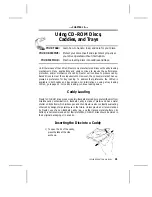
If other device drivers are loading before the CD-ROM driver, place them after the
CD-ROM driver. If the memory manager tries to load the CD-ROM driver into high
memory (e.g., DEVICEHIGH or LOADHIGH), disable the function so that the driver
is loaded into conventional memory.
Hardware Conflict Between the Interface Board and Your Computer
The SCSI interface board may be in conflict with another peripheral in your computer.
Normally, this conflict can be settled by selecting a different address for the SCSI
interface board. In some cases, you may wish to select a different address for the
conflicting peripheral.
If the driver still does not recognize the interface board, follow these steps:
1) Remove all non-essential peripherals from your computer (e.g., network
boards, fax boards, etc.) and their device drivers from the CONFIG.SYS and
AUTOEXEC.BAT files.
2) Reboot the computer and ensure that the CD-ROM device driver recognizes
the SCSI interface board.
3) Turn off the computer and reinstall each peripheral and its device drivers
one at a time.
4) Repeat steps 2 and 3 until the problem reoccurs. This means that the problem
is with the last peripheral you installed.
Improper MSCDEX Installation
The Microsoft CD-ROM Extensions (filename: MSCDEX.EXE) or equivalent files from
Corel (CORELCDX.EXE) are required to run your CD-ROM drive under MS-DOS or
DR DOS. If the SCSI driver was successfully loaded, check for proper installation of
MSCDEX.EXE by rebooting the computer and watching the AUTOEXEC.BAT file as it
executes for an error message.
SCSI Interface Board Not Properly Seated
If the SCSI interface board is not fully seated into the computer’s expansion slot, the
device driver software will not recognize it. Inspect the interface board where it seats
into the connector on your computer’s motherboard. There should not be more than
a small gap between the interface board and the connector.
CHAPTER 12 ---- Troubleshooting
12PLEX OPERATION MANUAL
53








































